3D Printing For Prototyping Market Size
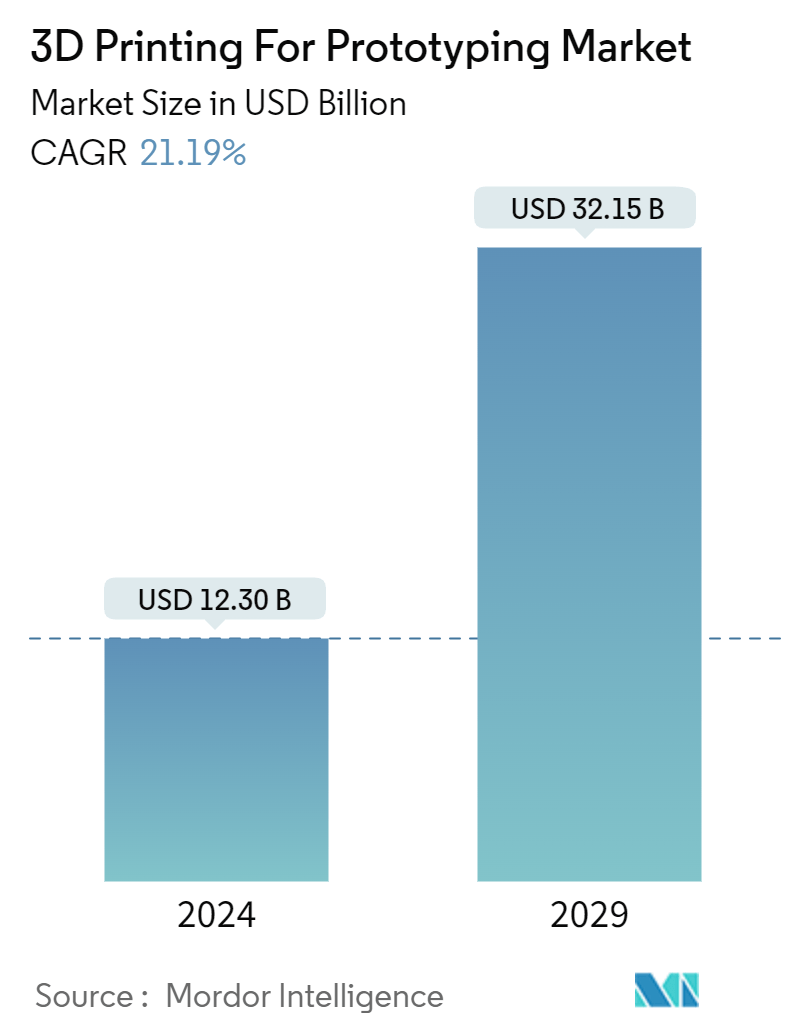
| Study Period | 2019 - 2029 |
| Market Size (2024) | USD 12.30 Billion |
| Market Size (2029) | USD 32.15 Billion |
| CAGR (2024 - 2029) | 21.19 % |
| Fastest Growing Market | Asia Pacific |
| Largest Market | North America |
| Market Concentration | High |
Major Players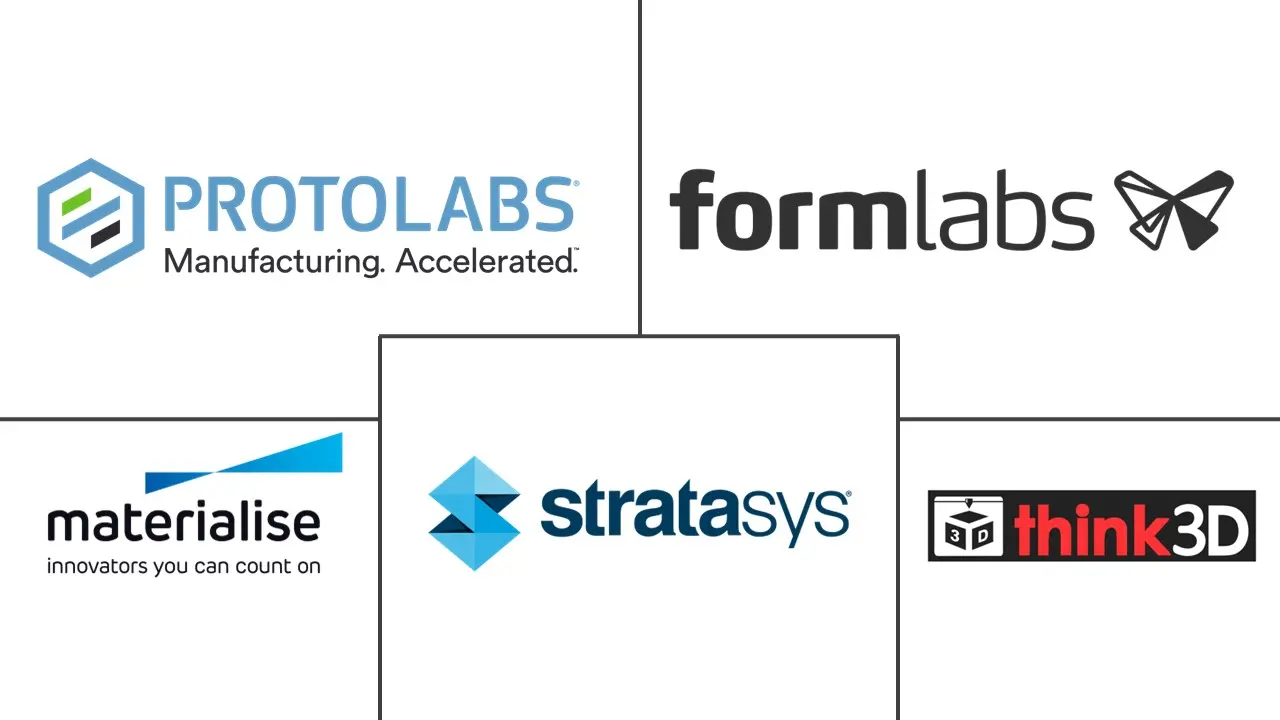
*Disclaimer: Major Players sorted in no particular order |
3D Printing For Prototyping Market Analysis
The 3D Printing For Prototyping Market size is estimated at USD 12.30 billion in 2024, and is expected to reach USD 32.15 billion by 2029, growing at a CAGR of 21.19% during the forecast period (2024-2029).
For the past several decades, 3D printing has been a swift and dependable method for producing multiple design iterations in prototyping. This approach reduces risks, conserves resources during product development, and accelerates decision-making, especially when selecting from various designs.
- 3D printing in functional prototyping enables product developers to create several iterations before moving to production tooling. This capability helps companies sidestep costly errors before launching new products. Moreover, functional prototypes can be crafted using materials closely resembling those of the final product, allowing them to be utilized during the product testing phase. Access to these physical prototypes also empowers companies to identify potential flaws before investing in expensive injection moulding tools.
- Owing to technologies like 3D printing, CAD, and rapid prototyping, businesses can tailor products to consumer preferences. As research and development intensifies across various sectors, the significance of 3D printing in prototyping grows, paving the way for even more advanced techniques.
- In recent years, the adoption of rapid prototyping has grown significantly across various end user industries as it significantly reduces material wastage for manufacturers due to its heightened accuracy and error-free operation. This precision has made 3D printing prototyping a favored choice in sectors like aviation and automotive, aiding designers in grasping their designs and potential flaws.
- Moreover, as the variety of compatible materials continues to expand, the adoption of 3D printing for prototyping is set to increase. Currently, a diverse array of materials enables product development teams to rigorously test prototypes under real-world conditions, assessing their performance against chemicals, weather elements, and mechanical stresses. Additionally, an expanding selection of materials closely resembles the final product, such as rubber-like substances and wood-filled composites.
- Despite its advantages, the market faces challenges due to the high costs associated with rapid prototyping and the demand for skilled professionals. When a manufacturing company embraces rapid prototyping technology, it incurs a significant initial investment. Additionally, the software essential for rapid prototyping comes with a hefty price tag. Moreover, as application areas evolve, the need to update rendering software further escalates the overall system costs.
3D Printing For Prototyping Market Trends
Aerospace and Defense Segment is Expected to Observe Significant Growth
- Like other sectors, the aerospace industry employs rapid prototyping to transform initial design concepts into ready-to-use parts. With 3D printing technologies, aerospace firms can produce and assess various design iterations by creating fully functional components. Engineers adeptly select specific 3D printers and materials, allowing for the swift production of prototypes with diverse forms, fits, and functionalities. Beyond expediting aircraft design cycles, 3D printing significantly shortens the time to market for aerospace companies.
- In aerospace, designs typically start as concept models that highlight specific aircraft components. These models play a pivotal role in aerodynamic testing, a crucial aspect of aerospace development. Techniques like SLA printing and material jetting are employed to create detailed and smooth scale models of aerospace designs. Such accurate models convey the design intent clearly and present the concept's overarching form. Hence, the growing aerospace industry creates a favorable ecosystem for the growth of the studied market.
- For instance, in 2023, the aerospace and defense (A&D) industry experienced a resurgence in product demand. In the aerospace sector, domestic commercial aviation revenue passenger kilometers in many countries exceeded pre-pandemic levels. This momentum in demand for A&D products and services is projected to persist into 2024.
- Commercial travel is set to maintain its upward trend. Meanwhile, as geopolitical tensions rise in the defense sector, the demand for defense products is anticipated to grow. According to IATA, global passenger kilometers in 2023 saw a 36.9% increase from 2022, bringing global air traffic to 94.1% of pre-pandemic levels. This rebound in air travel has been mirrored by a significant rise in aircraft orders and deliveries, further driving the evolution of flight recorder devices. In 2023, Boeing and Airbus reported deliveries of 735 and 528 commercial jets, respectively, marking an increase from 676 and 480 in 2022.
- Several firms in the aerospace and defense industry are harnessing the power of 3D printing for prototyping. For example, A&M Tool and Design manufactures parts and custom machines catering to aerospace, optics, and robotics. Over the years, A&M Tool and Design has evolved, integrating a suite of modern equipment, including 3D printing, alongside its trusted traditional technologies and retrofitted solutions. The vendor notes that it adopted 3D printing primarily to test fit and function during prototyping. With 3D printing, A&M Tool and Design can produce parts at an accelerated pace, maximizing their operational hours.
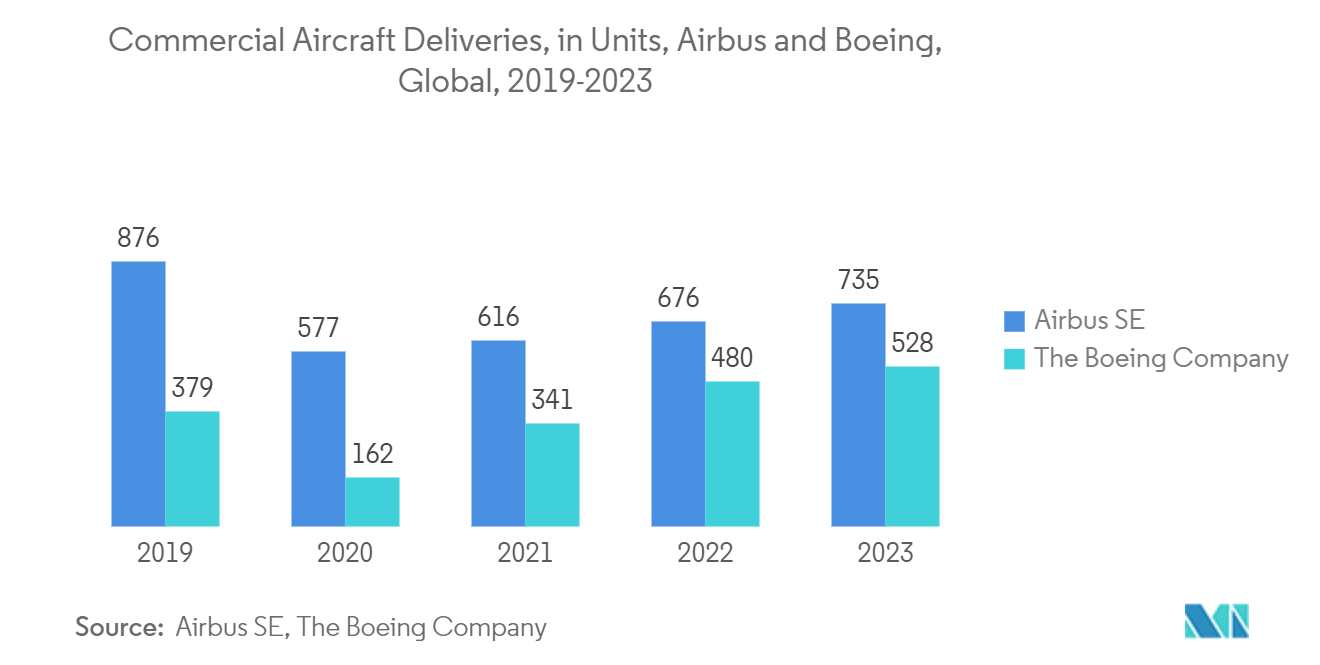
North America Expected to Hold Significant Market Share
- To thrive in the dynamic market, consumer product (CP) companies must prioritize adaptability, innovation, and differentiation. North America exemplifies these principles, seamlessly integrating technological advancements while attuning to market nuances. Armed with these competencies, North American nations adeptly cater to consumer demands, consolidate markets, and implement strategies with finesse.
- Research and development projects have seen a notable surge. The 2024 budget marked a significant uptick in federal R&D funding. The US president's proposal, pegged at USD 210 billion, underscored the intent to harness science and technology for the greater good of the American populace. Such advancements underscore the demand for streamlined and cost-effective innovation processes, with 3D printing prototyping leading the charge.
- The established presence of major end-user industries like aerospace and defense and automotive in the North American region, especially the United States, also creates a favorable ecosystem for the market's growth in the region. For instance, Boeing is among the leading commercial aircraft manufacturers. The company leverages additive manufacturing technology for various applications beginning from prototyping to custom part production.
- The United States stands as the dominant automotive market in North America, hosting globally renowned brands like General Motors and Ford. Many of these companies harness the power of 3D printing for their prototyping needs. Ford Motor Company utilizes 3D printing to craft prototypes of engine covers. This approach enables engineers to swiftly test and refine designs, leading to notable reductions in both lead times and production costs. Consequently, these trends and advancements bolster the growth of the studied market in the region.
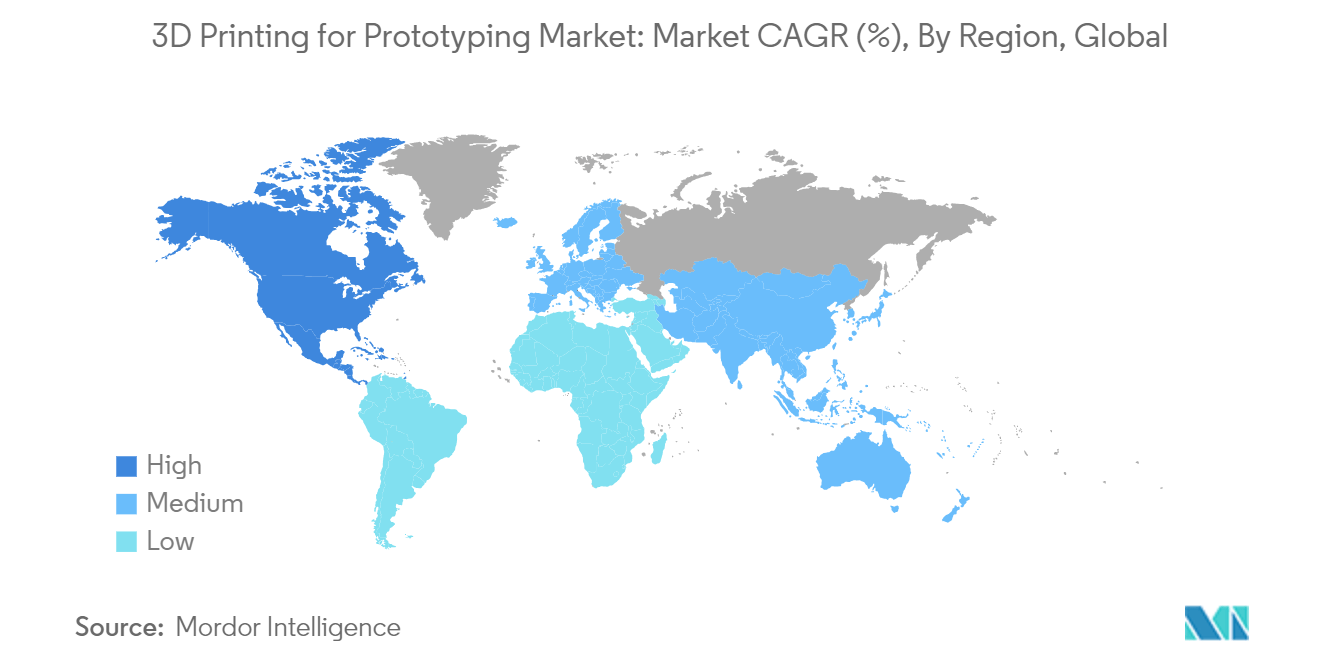
3D Printing For Prototyping Industry Overview
The 3D printing for prototyping market is becoming increasingly competitive, with several major vendors holding significant market shares and maintaining strong distribution networks. At the same time, new players are making their mark. To strengthen their foothold and broaden their reach, industry leaders actively engage in mergers and acquisitions and forming strategic partnerships. Such maneuvers are crucial for staying ahead in this swiftly changing landscape. Prominent players in this sector include Protolabs, Materialise, Stratasys, and Sopan Infotech.
One of the most significant trends shaping the future of 3D printing is the creation of specialized materials tailored for specific applications. These materials, ranging from biocompatible resins for medical implants to high-strength polymers for aerospace components, often exhibit properties that outshine traditional materials. As a result, market vendors should prioritize developing systems compatible with diverse material types to bolster their market presence.
Vendors should consider broadening their reach into the emerging markets of Asia-Pacific and Latin America. Major end-user industries, such as aerospace and defense, automotive, and healthcare, are witnessing rapid expansion in these regions. This growth creates a favorable ecosystem for the advancement of the 3D printing for prototyping market.
3D Printing For Prototyping Market Leaders
-
Proto Labs Inc.
-
Materialise NV
-
Stratasys, Ltd.
-
think3D
-
Formlabs
*Disclaimer: Major Players sorted in no particular order
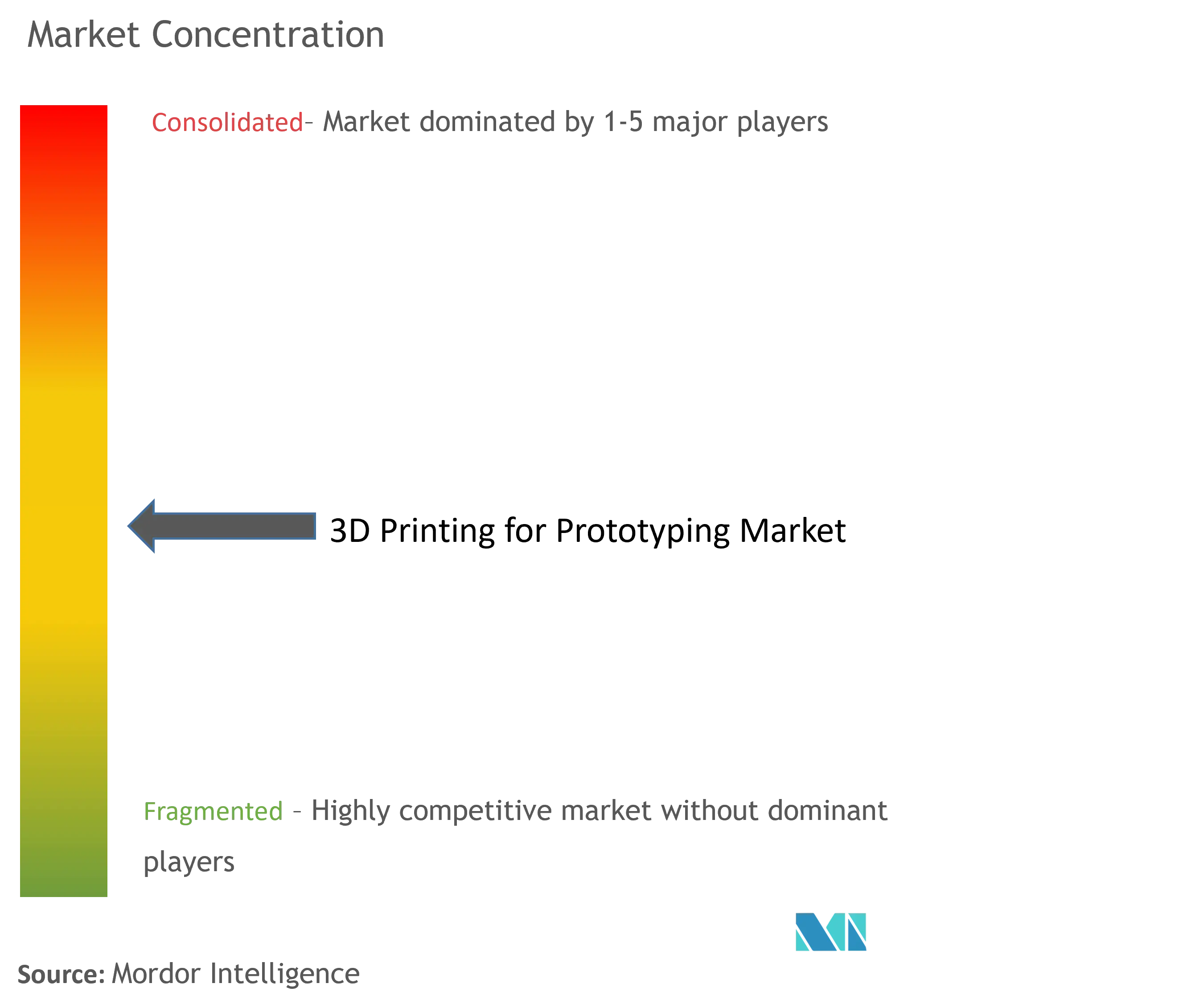
3D Printing For Prototyping Market News
- July 2024: Cubicure partnered with HARTING AG, a specialist in 3D Mechatronic Integrated Device (MID) solutions, to pioneer the 3D printing of Laser Direct Structuring (LDS) materials. The companies noted that previous attempts at 3D printing MID prototypes faced challenges related to resolution and material compatibility. However, this new technology promises direct 3D printing of LDS materials, boasting superior resolution and smooth surfaces. Furthermore, the printed materials can be effortlessly integrated into HARTING's existing LDS process, leading to notable time savings in producing prototypes and small series runs.
- April 2024: Formlabs unveiled Form 4, the pinnacle of speed and reliability in 3D printing. With its proprietary Low Force Display (LFD) print engine, Formlabs set a new standard in professional resin 3D printing. Boasting print speeds up to five times faster, the Form 4 enhances productivity, empowering professionals to embrace design risks and expedite their market entry.
3D Printing For Prototyping Market Report - Table of Contents
1. INTRODUCTION
1.1 Study Assumptions and Market Definition
1.2 Scope of the Study
2. RESEARCH METHODOLOGY
3. EXECUTIVE SUMMARY
4. MARKET INSIGHTS
4.1 Market Overview
4.2 Industry Value Chain Analysis
4.3 Industry Attractiveness - Porter's Five Forces Analysis
4.3.1 Bargaining Power of Suppliers
4.3.2 Bargaining Power of Consumers
4.3.3 Threat of New Entrants
4.3.4 Threat of Substitute Products
4.3.5 Intensity of Competitive Rivalry
4.4 Impact of Macro Economic trends on the market
5. MARKET DYNAMICS
5.1 Market Drivers
5.1.1 Growing Investments Toward Research and Development
5.1.2 Growing Shift Toward Sustainable Innovations
5.2 Market Restraints
5.2.1 High Cost Associated and Presence of Alternatives
6. MARKET SEGMENTATION
6.1 By Technology
6.1.1 Stereolithography
6.1.2 Selective Laser Sintering (SLS)
6.1.3 Fused Deposition Modeling (FDM)
6.1.4 Digital Light Processing (DLP)
6.1.5 Binder Jetting
6.1.6 Other Technologies
6.2 By Material Type
6.2.1 Metal
6.2.2 Polymer
6.2.3 Ceramic
6.2.4 Other Material Types
6.3 End-user Industry
6.3.1 Aerospace and Defense
6.3.2 Automotive
6.3.3 Healthcare
6.3.4 Consumer Good and Electronics
6.3.5 Other End-user Industries
6.4 By Geography
6.4.1 North America
6.4.2 Europe
6.4.3 Asia
6.4.4 Australia and New Zealand
6.4.5 Latin America
6.4.6 Middle East & Africa
7. COMPETITIVE LANDSCAPE
7.1 Company Profiles
7.1.1 ProtoLabs Inc.
7.1.2 Materialise NV
7.1.3 Stratasys Ltd
7.1.4 think3d.com
7.1.5 Formlabs
7.1.6 HLH Prototypes Co. Ltd
7.1.7 Sopan Infotech
7.1.8 PLM Group
7.1.9 Sculpteo
7.1.10 Fathom Digital Manufacturing
- *List Not Exhaustive
8. INVESTMENT ANALYSIS
9. FUTURE OF THE MARKET
3D Printing For Prototyping Industry Segmentation
Effective prototyping plays a crucial role in the product life cycle. Engineers can finalize a part design that meets the desired features and performance by continuously testing and refining iterations. For several years, engineers have turned to 3D printing for prototyping. This technology, known for its speed and reliability in producing multiple design iterations, significantly reduces risks and conserves resources during product development. Moreover, physical prototypes accelerate decision-making, especially when designers weigh multiple design options.
To estimate the market for 3D printing in prototyping, the study tracks the revenue generated from 3D printing solutions such as printers, materials, and services by leading market vendors globally. Furthermore, it also tracks several underlying growth influencers and broader macroeconomic factors to establish the market's growth trajectory and future landscape.
The 3D printing for prototyping market is segmented by technology (stereolithography, selective laser sintering (SLS), fused deposition modeling (FDM), digital light processing (DLP), binder jetting, and other technologies), material type (metal, polymer, ceramic, and other material types), end-user (aerospace and defense, automotive, healthcare, consumer goods and electronics, and other end-user industries), and geography (North America, Europe, Asia-Pacific, Latin America, and Middle East and Africa). The market size and forecasts are provided in terms of value (USD) for all the above segments.
| By Technology | |
| Stereolithography | |
| Selective Laser Sintering (SLS) | |
| Fused Deposition Modeling (FDM) | |
| Digital Light Processing (DLP) | |
| Binder Jetting | |
| Other Technologies |
| By Material Type | |
| Metal | |
| Polymer | |
| Ceramic | |
| Other Material Types |
| End-user Industry | |
| Aerospace and Defense | |
| Automotive | |
| Healthcare | |
| Consumer Good and Electronics | |
| Other End-user Industries |
| By Geography | |
| North America | |
| Europe | |
| Asia | |
| Australia and New Zealand | |
| Latin America | |
| Middle East & Africa |
3D Printing For Prototyping Market Research FAQs
How big is the 3D Printing For Prototyping Market?
The 3D Printing For Prototyping Market size is expected to reach USD 12.30 billion in 2024 and grow at a CAGR of 21.19% to reach USD 32.15 billion by 2029.
What is the current 3D Printing For Prototyping Market size?
In 2024, the 3D Printing For Prototyping Market size is expected to reach USD 12.30 billion.
Who are the key players in 3D Printing For Prototyping Market?
Proto Labs Inc., Materialise NV, Stratasys, Ltd., think3D and Formlabs are the major companies operating in the 3D Printing For Prototyping Market.
Which is the fastest growing region in 3D Printing For Prototyping Market?
Asia Pacific is estimated to grow at the highest CAGR over the forecast period (2024-2029).
Which region has the biggest share in 3D Printing For Prototyping Market?
In 2024, the North America accounts for the largest market share in 3D Printing For Prototyping Market.
What years does this 3D Printing For Prototyping Market cover, and what was the market size in 2023?
In 2023, the 3D Printing For Prototyping Market size was estimated at USD 9.69 billion. The report covers the 3D Printing For Prototyping Market historical market size for years: 2019, 2020, 2021, 2022 and 2023. The report also forecasts the 3D Printing For Prototyping Market size for years: 2024, 2025, 2026, 2027, 2028 and 2029.
3D Printing For Prototyping Industry Report
Statistics for the 2024 3D Printing For Prototyping market share, size and revenue growth rate, created by Mordor Intelligence™ Industry Reports. 3D Printing For Prototyping analysis includes a market forecast outlook for 2024 to 2029 and historical overview. Get a sample of this industry analysis as a free report PDF download.



